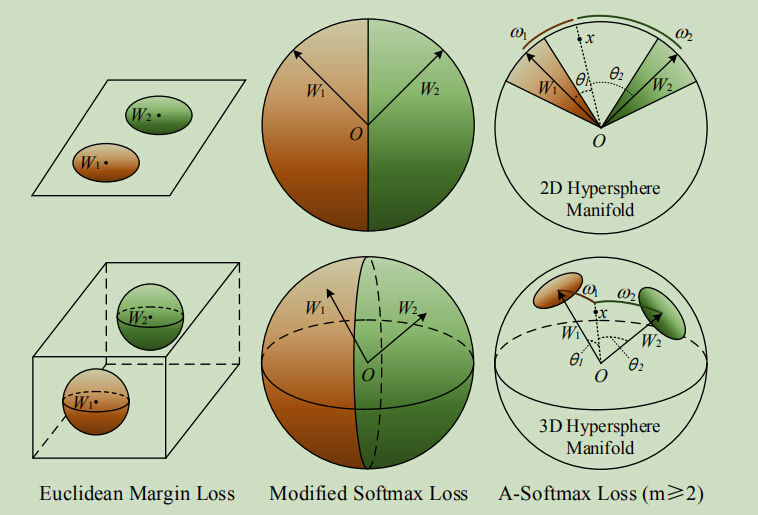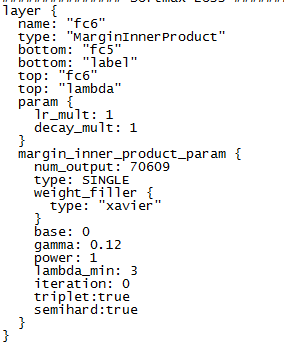ATL(Angular Triplet Loss)
Theory
basic theory
motivation
这个loss虽然叫做angular triplet loss,但实际上是从sphereface的想法上发展出来的。
在说动机之前,先简单的分析一下sphereface。
首先是下面这张图,这是sphereface的核心**之一:angular(论文中):
可以看到,origin softmax是没有将weights(分类权重)归一化的,这个我在之前的project(loss functions)中也分析过了,没有将weights归一化,那就永远属于欧式距离的范围。所以,只有将weights归一化,才能称之为cosine距离。
然后是这张图,sphereface的核心**之二:margin(论文中):


为什么需要这个m?就是希望它能够是样本满足 max intra-class angle < min inter-class angle。为了满足这个条件,作者推导出m=4,但是这个条件实在是太强了,强到违背了分布的规律,所以在代码中不得不加入lambda来进行调整。
在这么强的约束下,肯定是有一些样本是无法满足margin分类条件的,如果这些样本无法正确分类,然后这些样本的feature norm又很大的话,最终的loss自然会很大,所以这些样本的feature norm就会变小,这点在project(FaceRecognitionSystem)的norm select中分析过,如下图:
显然,对于上图中0038_02来说,确实很难分辨这个人是谁,m=4的要求对于他来说肯定是约束过强了。有没有一种方法能够在满足max intra-class angle < min inter-class angle的情况下同时又能自动的选择每个样本对于的margin呢?
triplet的apn理论非常的适合。如果我们normalize p,n;只更新a。这便既满足了angular又满足了triplet特性,便是angular triplet loss。
Implementation
triplet的随机选取apn的实现有些过于麻烦了,所以我直接基于sphereface的marginInnerProdect实现了一个Easy Triplet。
softmax是这样的,它要维护一个类中心(即分类层的权重),然后其他的样本去做分类。这个类中心在迭代的过程中不断更新,最终保持一种稳定的状态。
要命的是,这个类中心并不一定真的就是当类所有样本的中心位置。
所以在Easy Triplet里面,我舍弃了类中心的更新过程,直接把传进来的样本当成是新的类中心来做分类。具体实现可以参考代码。
同时,为了让收敛更快,我同样在代码里面实现了easy triplet的semihard example选择机制。
Result
Usage
caffe_layer
1.put marginInnerProduct.hpp/.cpp/.cu into caffe dir.
2.add
message LayerParameter {
...
optional MarginInnerProductParameter margin_inner_product_param = 147;
...
}
message MarginInnerProductParameter {
optional uint32 num_output = 1; // The number of outputs for the layer
enum MarginType {
SINGLE = 0;
DOUBLE = 1;
TRIPLE = 2;
QUADRUPLE = 3;
}
optional MarginType type = 2 [default = SINGLE];
optional FillerParameter weight_filler = 3; // The filler for the weight
// The first axis to be lumped into a single inner product computation;
// all preceding axes are retained in the output.
// May be negative to index from the end (e.g., -1 for the last axis).
optional int32 axis = 4 [default = 1];
optional float base = 5 [default = 1];
optional float gamma = 6 [default = 0];
optional float power = 7 [default = 1];
optional int32 iteration = 8 [default = 0];
optional float lambda_min = 9 [default = 0];
optional bool triplet = 10 [default = false];
optional bool semihard = 11 [default = false];
}
in your caffe.proto
alignment
use RSA for landmark detection && AlignWuXiang with ec-my-y = 40 and size = [112,112]
deploy
resface 28 layer(see in proto/face_deploy.prototxt)
train
method 1:step
step 1:
train a pre-trained model use sphereface.
step 2:
set triplet & semihard param to true.
method 2:directly train
set triplet & semihard param to true.
train with solver(see in proto/face_solver.prototxt)
trainning log will be upload soon
In my experiment,method 2 converge faster than original sphereface,so maybe there is no need for you to try different m and lambda_min if you want to get a good result.I'm still focus on this method nowadays.
final state
notice that original triplet loss also use Margin.So for small training set(like casia webface),you may set m=2 and lambda_min = 3 in Angular Triplet Loss.
Reference
1.FaceNet: A Unified Embedding for Face Recognition and Clustering
2.SphereFace: Deep Hypersphere Embedding for Face Recognition
Thanks
@happynear @deepinsight
Contributor
@KaleidoZhouYN




